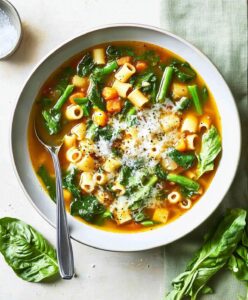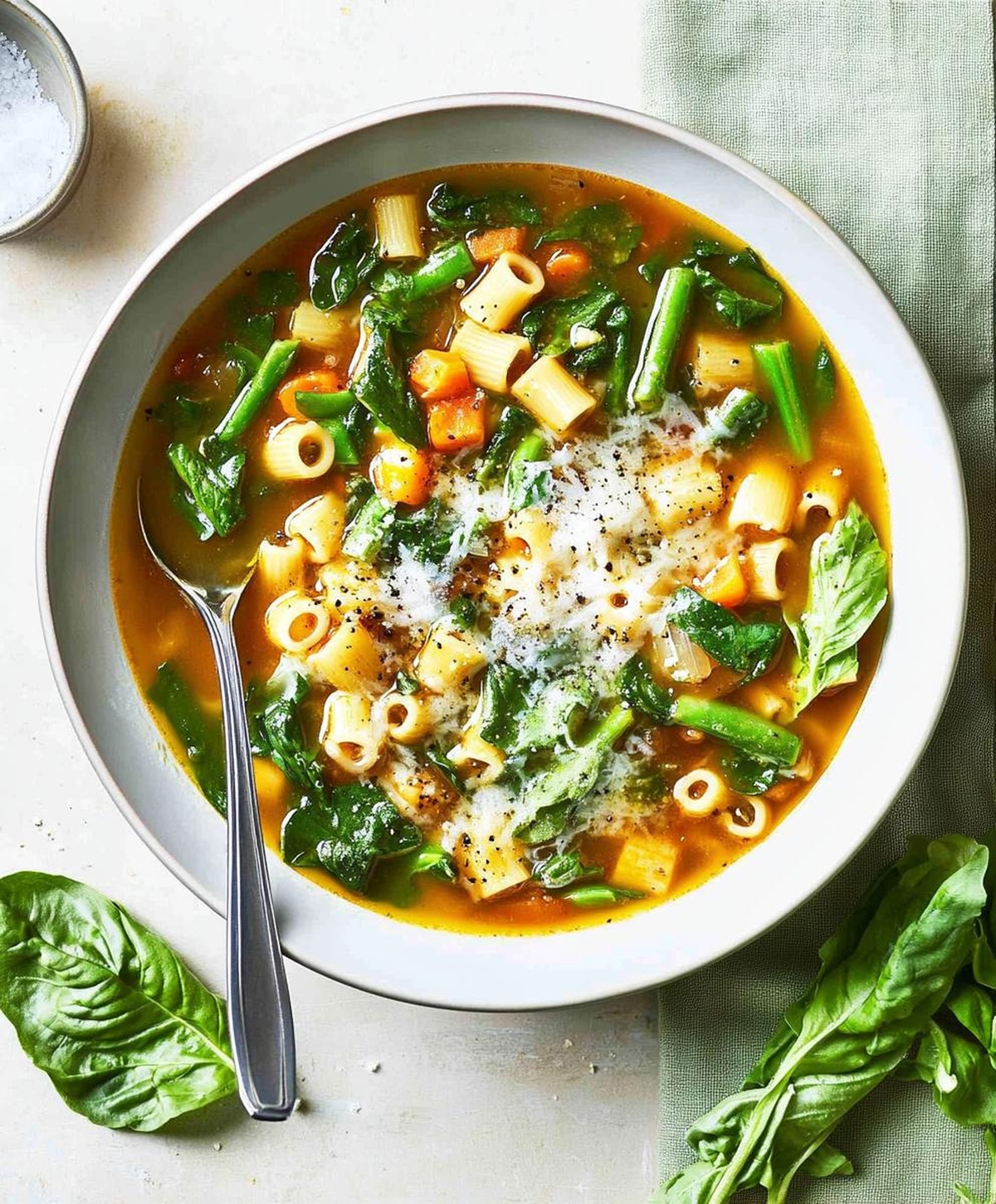Bright & Hearty Spring Minestrone Soup Recipe To Enjoy Now
Weeknight dinners demand quick, hearty solutions that satisfy and warm the soul, and this spring minestrone soup recipe delivers pure comfort with fresh seasonal ingredients.
Vibrant vegetables dance through a rich, savory broth, creating a melody of flavors that sing of spring abundance.
Each spoonful brings layers of textures and tastes that promise wholesome nourishment.
Tender beans, crisp vegetables, and aromatic herbs combine in a delightful culinary symphony.
The soup transforms simple ingredients into a meal that feels both rustic and refined.
Packed with nutrients and bursting with color, this minestrone turns an ordinary evening into a celebration of seasonal cooking.
You’ll want to ladle this soup into deep bowls and savor every delicious bite.
FAQs
Yes, this spring minestrone is packed with nutrients. It contains protein from chickpeas, vitamins from multiple vegetables like kale, asparagus, and zucchini, and offers a balanced, low-calorie meal option.
The recipe is already vegetarian and vegan-friendly. It uses vegetable stock, plant-based ingredients, and no animal products, making it perfect for those following plant-based diets.
Small pasta shapes like orzo, ditalini, or small shells are ideal. They cook quickly and provide a nice texture without overwhelming the vegetables. Choose whole wheat options for added nutrition.
Consider adding additional protein sources like white beans, tofu cubes, or lentils. You could also sprinkle nutritional yeast or top with roasted nuts for extra protein and flavor complexity.
What Sets Spring Minestrone Soup Apart
Ingredients Needed for Spring Minestrone Soup
Base Vegetables:Additional Vegetables:Herbs and Seasonings:Protein and Starch:How to Make Spring Minestrone Soup
Step 1: Prep and Warm the Cooking Vessel
Pour olive oil into a large pot over medium heat.
Add chopped spring onions and diced celery, allowing them to become soft and fragrant.
Gently stir the vegetables, watching them transform and release their delightful aromas.
Step 2: Introduce Crisp Seasonal Vegetables
Toss in:Stir these fresh vegetables into the softened onions and celery.
Cook for four to five minutes, ensuring they maintain a slight crispness while becoming tender.
Step 3: Awaken Herbal Aromatics
Sprinkle in:Stir quickly and cook for one minute.
Watch the herbs release their intense flavors, filling your kitchen with an incredible scent.
Move swiftly to prevent garlic from burning.
Step 4: Build the Soup Foundation
Add to the pot:Increase heat to create a gentle boil, then reduce to a simmer.
Cook for ten minutes, stirring occasionally to prevent pasta from sticking.
Aim for al dente pasta with a slight bite.
Step 5: Brighten and Finish the Soup
Squeeze fresh lemon juice into the pot.
Fold in roughly chopped kale, covering with a lid.
Simmer for two to three minutes until kale wilts but maintains its vibrant green color.
Season with salt and pepper to taste.
Add extra lemon juice if desired for a zesty touch.
Serve hot and enjoy the burst of spring flavors!
Helpful Tips for Fresh Minestrone Soup
Storage and Reheating Guide for Spring Soup
Great Sides to Pair with Minestrone
Easy Ways to Customize Spring Minestrone
Print
Spring Minestrone Soup Recipe
- Total Time: 30 minutes
- Yield: 4 1x
Description
Hearty spring minestrone soup celebrates seasonal vegetables with a delightful Italian twist. Fresh ingredients and rich broth create a comforting meal you’ll savor with each spoonful.
Ingredients
Main Vegetables:
- 12 asparagus spears, chopped
- 1 medium zucchini, diced
- 8 spring onions (scallions), chopped
- 2 celery stalks, diced
- 100 g (3.5 oz) kale, roughly chopped
- 2 large garlic cloves, finely chopped
Herbs and Seasonings:
- 1 tablespoon fresh rosemary, finely chopped
- 1 tablespoon fresh thyme, finely chopped
- Salt and pepper to taste
- Juice of half a lemon
Protein and Other Ingredients:
- 1 x 400 g (14 oz) can chickpeas, drained and rinsed
- 100 g (3.5 oz) ditalini or another type of small pasta
- 1 tablespoon olive oil
- 1.5 litres (6 cups) vegetable stock
Instructions
- Heat olive oil in a large pot over medium temperature (around 350°F). Sauté spring onions and celery for 2-3 minutes until they become fragrant and slightly softened.
- Incorporate asparagus and zucchini into the pot. Cook for 4-5 minutes, stirring occasionally to ensure even heating and prevent sticking. Vegetables should remain slightly crisp.
- Add garlic, rosemary, and thyme. Quickly stir for 60 seconds, allowing herbs to release their aromatic oils without burning. The kitchen will fill with a rich herbal fragrance.
- Pour in vegetable stock, then introduce chickpeas and small pasta. Increase heat to bring mixture to a gentle boil, then reduce to a low simmer for 10 minutes. Stir periodically to prevent pasta from clumping.
- Reduce heat to low. Squeeze fresh lemon juice and fold in chopped kale. Cover and simmer for 2-3 minutes until kale wilts but maintains its vibrant green color. Adjust seasoning with salt and pepper to taste.
- Remove from heat. Let soup rest for 2 minutes to allow flavors to meld. Ladle into serving bowls, optional: garnish with additional lemon wedge or fresh herbs if desired.
Notes
- Customize heat levels by adjusting the amount of herbs and spices for different palate preferences.
- Use fresh seasonal vegetables to enhance the soup’s flavor profile and nutritional value.
- Swap chickpeas with white beans or lentils for alternative protein sources and dietary needs.
- Prepare the base vegetables in advance to streamline cooking process and save time during meal preparation.
- Prep Time: 15 minutes
- Cook Time: 15 minutes
- Category: Lunch, Dinner, Appetizer
- Method: Simmering
- Cuisine: Italian
Nutrition
- Serving Size: 4
- Calories: 150
- Sugar: 2 g
- Sodium: 400 mg
- Fat: 4 g
- Saturated Fat: 0.5 g
- Unsaturated Fat: 3 g
- Trans Fat: 0 g
- Carbohydrates: 24 g
- Fiber: 6 g
- Protein: 7 g
- Cholesterol: 0 mg


Clara Thompson
Recipe Developer & Culinary Educator
Expertise
Developing accessible single-serving recipes, Food writing and content creation, Plant-based and allergen-friendly cooking, Culinary education and workshop facilitation
Education
Oregon Culinary Institute (Portland, OR)
Diploma in Culinary Arts
Specialized in plant-based cooking and sustainable kitchen practices.
Portland Community College
Certificate in Food Writing and Media
Focused on recipe writing, food photography, and digital content creation.
Clara’s food journey began with a curiosity for color, texture, and ingredients pulled straight from the garden. Her background in plant-forward cooking and creative writing gives her a unique edge – she makes healthy, flavorful food feel inviting, not intimidating.
She specializes in meals that work for busy lives and different diets, all without sacrificing taste. Clara’s voice comes through in every recipe she writes – clear, kind, and encouraging.